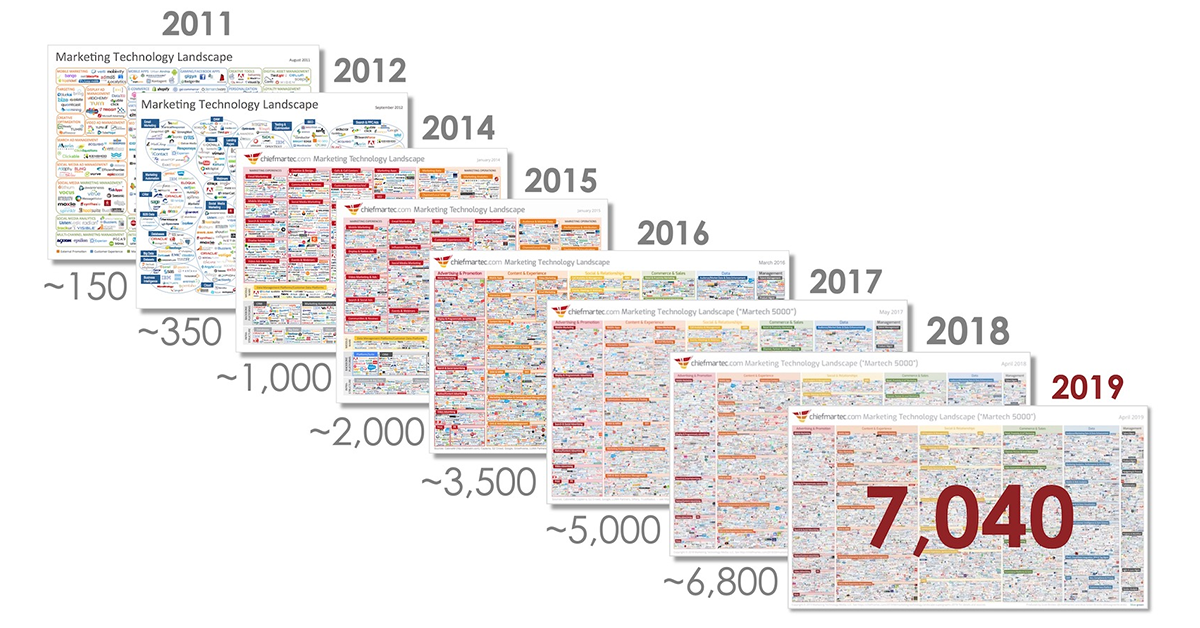Marketing Technology (Martech) – the complex blend of marketing and technology – is a convoluted landscape. There are a plethora of vendors that make up the martech supply chain.
Starting at 150 options 8 years ago (which most would agree provides plenty of choice) we've now got a range that no subject matter expert could ever be across. While the proliferation of SaaS martech providers affords and allows significant choice, it also introduces complexities and challenges. For perspective, below is the growth in the martech vendors over the past eight years. The martech landscape has grown annually by double or triple digits. In 2017, there was a 39% growth in the number of solutions. 2018 saw a 27% growth. In 2019 the growth has been only 3% on the previous year. Although it would be fair to consider this as a slowing down, we are still left with too much choice.

One side of the equation is the vendors, and above is the growth in the overall landscape. The other side of the equation is the client’s perspective. The martech acquisition process is arduous, long and complicated. The complexity is particularly high in the case for organisations that have large and complex deployment needs. The procurement of martech solutions must not be a decision taken lightly. Buying organisations go through substantial research in analysing the martech landscape. They engage with vendor sales execs over several meetings. They sit through numerous demos. The leadership team and the buying committee evaluates proposals and runs various test drives before making the best possible choice for their organisation.
With the plethora of martech solutions, organisations must exercise diligence and care as to which solutions, apps and technologies become part of the organisation’s martech arsenal.
Below, I have sketched out some food for thought as to how organisations should approach the ‘which martech solutions should we adopt from the 7,000 out there’ question.
Let me start by saying, there is absolutely no way to evaluate all 7,000 – not even read the feature list of each one. So, how on earth would you know which of the 7,000 martech apps are right for your business? Well, you are going to have to use a combination of a systematic approach to narrowing down, in conjunction with some crowd sourcing based on popularity. I’m making the presumption that you are not an early adopter if you are reading this and therefore not too concerned with those products that are on the bleeding edge.
What are the business and marketing objectives?
For marketing to add value to the business, it must remain aligned with the business objectives. Marketing leaders must guide their martech solution decisions to be in line with marketing initiatives that meet the business’ objectives. The martech apps and technologies that become part of your technology landscape must serve to deliver real and measurable value to the business. If the martech solution does not advance the business’ agenda in a visible and quantifiable manner, it should not become part of your martech landscape.
I say this as a person who has sat through far too many Salesforce demonstrations. The sales exec adds in the map visualiser, which gives you a heat signature over all the concentrated areas where your clients are based. On a map of the world, you see exactly where they are located. You can zoom in to dense areas, and it is an impressive visual. But does this actually give you precise ability to deliver on your business objectives, marketing activities or even enrich the quality of your analysis? I cannot say what it means for you, but I have seen many clients eating out of the sales exec’s palm even though I knew it did not add any significant benefit. So, I think the moral of this is “don’t get wowed by the shiny things unless they really bring real value”. The best way to stay focused on your goals is to remove as much emotion as possible from the evaluation process.
Recognise that a ‘Marketing Stack’ is more of a ‘Marketing Matrix’
The tech industry frequently places technologies in the ‘stack’ arrangement. ‘Tech Stacks’ are commonly discussed in technology circles. So too, ‘Marketing Technology Stacks’ are also discussed in marketing circles. ‘Martech stacks’ are based on the assumption that marketing technologies line up unidirectionally. Fact is, martech assortment is not linear. It is not unidirectional either.
A stack is a neat, structured, linear representation. However, in most cases, the way technologies sit within an organisation, they are arranged like a matrix. This is owing to the legacy systems that lie within a business. Often new technologies sit on top or aside a legacy system. Hence, there is no single correct answer as to how martech apps can the . It depends on the industry, the nature of work your organisation conducts, the customer data, and how it is housed today vs what is the best for unified customer experience.
Single vendor or a mix of best-in-breed vendors – Which is best?
Marketers face the decision of choosing a single vendor or a mix of best-in-breed vendors to meet their martech needs. When it comes to technology solutions, buying organisations often sit in two camps. They either subscribe to a ‘one vendor’ philosophy whereby a majority of their marketing technology needs are catered for by one large martech provider (such as Marketo or Adobe AEM). Or they subscribe to a ‘best-in-breed’ vendor philosophy.
There are benefits to both approaches. And as is expected, downsides to both.
The pros and cons of the single vendor approach
With a single vendor, there is only one vendor relationship to manage. This means that as a buyer, you need to educate just one vendor organisation about your business. This lowers the cost of the administration. You are not burdened with the necessity of repeating the same message to several vendors and their preferred integrators (and I’m not talking about just the initial delivery but actually getting true buy-in of what you want to achieve – this is not a small task).
Working with one vendor also brings the additional advantage of the synergy that exists between the vendor’s product offerings. The tools that a vendor offers would typically integrate and communicate well with one another. Given that these tools must work together to deliver your marketing outcomes, this is an important factor. More seamless integrations lower the burden for the buyer organisation having to deal with some of these hassles (but not all).
Single vendors, if they are strategic in their engagement, will develop an in-depth understanding of your business and consequently of your marketing needs. If there are issues with the technology, in a single vendor situation, there is only one vendor to contact, rather than try to work out which of your many vendors you need to call.
Just as there are upsides to a single vendor approach, there are downsides too. Buyers must bear in mind that no single vendor caters to all the needs of an organisation. Implementing a single vendor puts all the buying organisation’s eggs in one supply chain basket. This can prove to be a challenge. First and foremost, single-vendor solutions are often cost-prohibitive. For a smaller organisation, it is difficult to justify the investment. Large enterprises with exorbitant marketing budgets are more capable of affording the single vendor pricing. Further to the acquisition, the other downside of single-vendor solutions can be the price increases over time and the implementation costs, which generally match the software costs in the first couple of years.
When you are subscribed all in (into one vendor’s offering) and have built your marketing play around one vendor, you are, to a great extent, locked in. One vendor typically does not have expertise in all elements of the martech requirements of an organisation. The vendor usually excels in a few core areas and assembles capability in other areas through the course of business. Their expertise generally is most reliable in their core offering. No one organisation can do everything well. Leveraging a single vendor means hedging all bets onto one vendor and trusting them to do ‘it all’ well, and that too at a reasonable price.

The pros and cons of the best-in-breed vendors approach
A majority of marketers leverage best-in-breed solutions to make up their martech landscape. The number of marketers that subscribe to single vendor thinking is on the decrease – especially as integration platforms are on the rise (feel free to ask me about SiPHON).
Most marketers realise that embracing a best-in-breed approach allows for a higher degree of control over specific requirements. For instance, if an organisation seeks a solution for social media marketing management, it could leverage the single vendor’s offering, which is not a market-leading offering in the space. Or the organisation could choose a best-in-breed social media marketing management tool that does one thing only but does it well.
Best-in-breed solutions are often much closer to ‘plug and play’ and can be implemented with relative ease, as and when needed. They serve to be just in time solutions that can be the right point solutions for the required use case.
Best-in-breed solutions can help marketers focus on specific aspects of marketing, be it email marketing, marketing automation, website analytics etc. By employing best-in-breed, marketers often get better results for particular use cases.
Here again, just as there are upsides of a best-in-breed vendors approach, there are downsides too. Choosing best-in-breed vendors means the buying organisation must cater to the relationship-building process (and understanding your business objectives) with several vendors. They must train their marketing team members across various products and solutions. Several vendors mean several implementations. Equally pertinent to note is the need to integrate several pieces of technology (or else, you end up with several point solutions that do not work as a cohesive solution). Getting the most out of a best-in-breed solution involves learning and mastering various technologies, coordinating several processes and orchestrating several moving parts and components. Also, single-vendor solutions are comparatively easier to keep track of when it comes to the ROI conversation. When you employ a variety of point solutions furbished by multiple vendors, it becomes incrementally complex to establish ROI of those individual functions. You will be able to show ROI over the whole stack, but possibly not which parts are the real winning components and which aren’t worth the time, cost or energy.
What is the real cost of the solution?

Regardless of whether an organisation decides to choose its martech solution from one vendor or an assortment of several best-in-breed vendors, the solutions come at a cost. Which apps or technologies make it into your stack must be driven by the budget. It is important for the buying organisation to be aware of its budget constraints and the options that the organisation considers must be based on the constraints. Also, while considering the costs of a solution, organisations must take into account not only the licensing costs but also the minimum term of the agreement, implementation costs, ongoing support and maintenance costs, training costs, upgrades (which includes implementing and training of new features with each upgrade) etc. Organisations must think beyond apparent and obvious costs to include all associated costs.
Are you getting what was promised?
Sometimes buying organisations end up signing up for a solution based on the features of a solution presented in the sales cycle. It is only upon implementation that the client realises that some of the features are part of the enterprise suite or an add-on. It is important to know upfront, which features of the solution are available as part of the solution you are procuring, and which features are part of a higher-priced version, or as an add-on. This may sound like the oldest trick in the book, but I saw it happen again only just yesterday.
Do you really need all those features?
When deciding which martech solutions to procure, an organisation must have a clear understanding of the features it requires. These features must be linked to the marketing goals and objectives, which in turn must underpin the business goals and objectives. It is important you procure the edition of the solution that matches your business requirements.
Some pertinent questions to ask:
- Do we really need all these features?
- Will we need them tomorrow?
- What is the return on investment for the higher edition?
Do you have all the features you need today – and tomorrow?
Just as it is important to ensure that you don’t end of buying an edition that you don’t require for your business, so too, it is important you procure a solution that meets your business needs today – and tomorrow.
Some pertinent questions to ask:
- Does the solution have all the features we need to meet our business objectives in the current period?
- How is our business evolving and as such, what will be the goals and objectives over the coming years?
- Does the solution have all the features we need to meet our business objectives over the coming years?
How easy is it to find skilled talent for this piece of tech?
Martech vendors might promote that their solutions are ‘Plug and Play’. However, often, it is upon implementation that you realise that the tech or app is not as self-operating as you were sold. Yes, the promise of revolutionising your marketing efforts still holds true but achieving that is not as simple as hitting a button. Not all businesses have the specialist skills in-house. This makes the choice of vendor and availability of skills in the market important factors to consider. Without the right skills, you will not get the return on investment you are aiming for. Is this technology widely deployed and understood? Will we be able to find skills to get the best from this technology? These questions should form the basis of your decision making.
How well will the vendor support us?
Without the right support, you will struggle to get a return on your investment in a martech solution. The implementation of martech apps and technology requires skills. If you don’t have the skills in-house, the support from the vendor becomes even more important. When you are evaluating various solutions, please pay very close attention to each vendor’s assurance of support. Assess the support service levels and the associated costs, especially over time. The promised user experience must meet your expectations and objectives as seamlessly and efficiently as possible. During this initial implementation and transition period, you will need the vendor’s support to assist with any data migration. This process must be as seamless as possible. Disruptions to business operations can prove to be expensive and are often time-consuming. The right support and service levels from the vendor can eliminate or at least reduce the disruptions. If the vendor is unable to provide the support and service levels you require, working with an accredited partner for implementation, configuration and ongoing support is usually a reliable option. The partner could work more closely to address your specific needs than a vendor can.
How difficult is it to learn?
I am a big Apple fan. What I love about Apple is not the technical wizardry or cool branding. It's not that the camera gains a few megapixels each year of that the material that constitutes the chassis, changes. I love the design and simplicity. I love how intuitive the products are to use and how easy they are to master. If your martech solution requires extensive learning, chances are it is too complex. The martech apps that become part of your technology family must be easy to learn, easy to master and easy to leverage.
Have you considered all relevant buying criterion?
When considering a martech solution, it is important to meet the generic and specialist requirements of the business. Often marketing teams are rushed in the assessment phase, and they end up picking martech solutions that meet the generic needs but fail to deliver on the specialist requirements. This can be a costly exercise. Procurement must be strategic. There must be a very clear understanding of which features are generic, and which are specialist. Equally, there should be a clear understanding of which criterion are essential, and which are non-essential.
The following questions are of pertinence and must be asked:
- What is the essential buying criterion?
- What is the non-essential buying criterion?
- Which generic features do we need in the solution – today, tomorrow?
- Which specialist features do we need in the solution – today, tomorrow?
- What are the gaps in the current system that need to be addressed?
- What features must the new solution have in order to fill those gaps?
- What features will be necessary for the future?
The analysis of future requirements is crucial. As your business grows, scales and evolves, you need a martech vendor that will adapt with you. Can the martech solution that meets your needs today, meet your needs five years from today? The moment you hear a resounding yes, please add that vendor solution to your shortlist.
In a world overrun by choice, making even the simplest business decisions can be a complex process. When it comes to choosing new marketing technologies, it pays to dig deeper than glib promises and fancy features. Run your potential martech vendors through a rigorous pitch process and find the one that is best suited to your business needs.
The ‘data’ aspect

Most martech solutions either host or leverage some elements of customer data. This customer data or the ability to leverage it is the lifeblood of the martech tool. The tool serves as the vehicle between the customer data and customer experience. Whilst tools might be able to solve individual customer pain points; they need to work with the complete context of every customer. This is the key to Personalisation, Attribution, Lead qualification, Reporting, Compliance etc. The martech solutions you pick must take into account the data aspect. Or else you end up with data silos. And to leverage martech solutions successfully to drive a business outcome, the data must be consolidated and leveraged as a whole.
What happens when you have too many martech apps?
Martech solutions are often procured to solve marketing challenges. Today, there is an abundance of choice when it comes to martech solutions. With the choice comes the temptation to overbuild the tech stack. Over time you end up with several point solutions. These point solutions, which once played a role in your business, might play a lesser role with the passage of time. They still linger on in your technology landscape. They don’t communicate well with one another, and now you have several technologies, sitting side by side but not working well together. This leads to a poor return on investment in marketing solutions.
Conclusion
Hopefully, I’ve demonstrated that there is a way through the heavily populated marketing technology world. If you’re looking to go on this journey, feel free to reach out to me. I love to throw ideas around over a coffee. I enjoy talking blue-sky thinking and turning ideas into solutions. I believe everyone should get to experience technology as we do.
Creative Folks are consultants focused on empowering content creators through technology. We are made up of Lead Consultants, Solution Architects, Business Analysts, Developers and Engineers. To find out more about what we do, contact us.



 Previous
Previous



